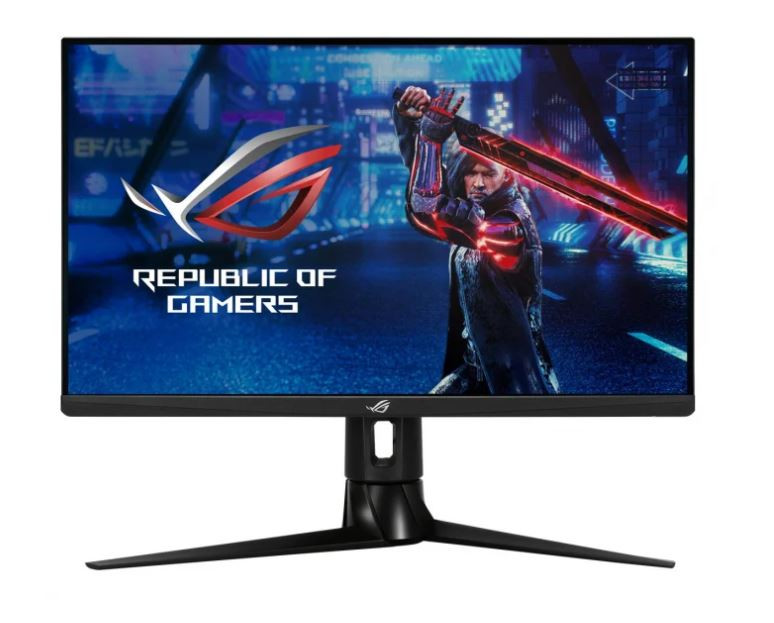



















£369.49*
- Resolution 2560 x 1440 QHD / WQHD
- Diagonal 27"
- Panel type IPS
- Refresh Rate 144Hz



Product information
ROG Strix XG27AQ HDR Gaming Monitor - 68.58cm (27 inch) WQHD (2560 x 1440), Fast IPS, overclockable to 170Hz (over 144Hz), 1ms (GTG), ELMB SYNC, G-SYNC Compatible, DisplayHDR ™ 400
27-inch (68.58cm) WQHD (2560 x 1440) Fast IPS gaming monitor with ultra-fast 170Hz refresh rate (overclocked), designed for professional gamers and immersive gameplay
The ASUS FastIPS technology enables a response time of 1ms (GTG) for sharp gaming graphics with high frame rates.
Thanks to the G-Sync Compatible certification, the ROG Strix XG27AQ delivers a seamless gaming experience without tearing by using a variable refresh rate (VRR) as standard.
ASUS Extreme Low Motion Blur Sync Technology (ELMB SYNC) enables ELMB to be used simultaneously with G-SYNC Compatible to prevent ghosting and tearing. The result is razor-sharp gaming graphics with high frame rates.
High-Dynamic-Range (HDR) technology with professional color space delivers a contrast and color performance that meets the requirements of DCI-P3 95% and the DisplayHDR ™ -400 certification
Full HD (1920 x 1080) @ 120Hz & 1440P (2560 x 1440) @ 60Hz output on PS5, 1440P (2560 x 1440) @ 120Hz VRR output on Xbox Series X / S
Extremely detailed image display and contrast
The WQHD panel (2560 x 1440) provides up to 77% more space on the desktop than a standard Full HD monitor (1920 x 1080) and also offers an impressive contrast ratio of 1,000: 1.
ASUS Fast IPS display with 1ms (GTG) response time The ASUS Fast IPS display enables the liquid crystals in the display to switch up to four times faster than conventional IPS panels, which leads to improved responsiveness. With a response time of 1 ms, trailing effects and motion blur are practically completely eliminated. This screen also delivers outstanding picture quality and outstanding colors thanks to the DCI-P3-95% color space display and an impressive contrast ratio of 1,000: 1. The high viewing angle of 178 degrees ensures that distortions and color deviations are as low as possible, even from extreme viewing angles.
INCREDIBLY FAST 170HZ FRAME RATE
Thanks to the uniquely fluid image reproduction, the player always has the upper hand, whether in first-person shooters, racing games, real-time strategy or sports titles.
Certified NVIDIA G-SYNC Compatible Delivers a seamless gaming experience without tearing by activating the variable refresh rate (VRR) by default in conjunction with an NVIDIA graphics card from the GTX 10 or RTX 20 series.
PRECISE, WIDE RANGE OF COLORS
Offers a wider color spectrum with the cinema standard color space DCI-P3 95%. To ensure high color accuracy, all monitors are pre-calibrated at the factory and provided with a calibration report.
ASUS AURA SYNC LIGHTING
With the exclusive ASUS Aura Sync lighting technology, the ROG Strix XG27AQ offers atmospheric ambient lighting that can be synchronized with other Aura-enabled components and peripherals.
HIGH DYNAMIC RANGE (HDR) WITH DISPLAYHDR ™ 400
HDR technology supports a wide range of luminance levels to provide a wider color range and higher contrast than conventional monitors. The extremely bright white and the deepest black enable an unprecedented brilliance in the representation of details. In addition, a peak brightness of 400cd / m² is achieved in order to meet the requirements of the DisplayHDR ™ 400 certification
Dynamic Shadow Boost
The ASUS Dynamic Shadow Boost technology automatically ensures better visibility of dark areas in the game without changing other areas. This not only leads to a better overview, but also makes it easier to track down hidden enemies in dark corners.
Versatile connection options
Comprehensive connectivity options, including inputs and outputs: DisplayPort1.2 and HDMI (v2.0) to support a wide range of multimedia devices.
Technical data
| Name | Asus XG27AQ ROG Strix 27" IPS Monitor, 2560 x 1440 QHD / WQHD, 144Hz, 1ms |
|---|---|
| Article number | 1000017504 |
| GTIN/EAN | 4718017926256 |
| Manufacturer SKU | 90LM06U0-B01370 |
| Model name | XG27AQ ROG Strix |
| Brand | Asus |
| Product Type | Monitor |
| Product Series | Asus XG Series |
| Technology | LCD |
| Panel type | IPS |
| Resolution | 2560 x 1440 QHD / WQHD |
| Diagonal | 27" |
| Aspect Ratio | 16:9 |
| Viewing angle - Horizontal | 178° |
| Viewing angle - Vertical | 178° |
| Contrast Ratio | 1,000 :1 |
| Max. Brightness | 400 cd/m² |
| Response time | 1ms |
| Refresh Rate | 144Hz |
| Support - VESA | 100 x 100 |
| Inputs | 1x 3,5mm Jack , 1x Displayport , 2x HDMI , 3x USB-A |
| Product width | 61.1 cm |
| Product height | 36.7 cm |
| Product depth | 8.2 cm |
| Weight | 8.6 kg |
| Colour | Black |
| EEK Spectrum | A to G |
| Energy efficency class | G |
| Delivery contents | Power cable , Quick user guide |
| Condition | New |
| Warranty | 24 Month |
| Warranty type | Bringin service Service and support information |
Downloads
Product safety
| Person responsible for the EU |
|---|
| Ninepoint GmbH |
| Im Mediapark 8 |
| 50670 Köln |
| Germany |
| info@asus-shop.de |



